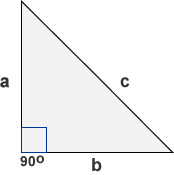a2+b2=c2
- c= hypotenuse
- a|b→ the angle between a and b, is 900
- The side opposite the right angle is called the hypotenuse (side c in the figure)
- If the length of both a and b are known, then c can be calculated as
- If the length of the hypotenuse c and of one side (a or b) are known, then the length of the other side can be calculated as
Pythagorean Theorem :
The square of the hypotenuse c (the side opposite the right angle) is equal to the sum of the squares of the other two sides (a,b)
. The theorem can be written as an equation relating the lengths of the sides a, b and c, often called the "Pythagorean equation": a2+b2=c2
Notes :
› Hypotenuse
c is always the longest side of the triangle ⇒
c>a και
c>b
›
Attention : The above equation is valid Only in right triangle
a2+b2=c2 ⇒ c2>a2 και c2>b2
a,b,c>0
⇒c>a & c>b
› The Pythagorean Theorem only works on right triangles, and by definition only right triangles can have a hypotenuse. If your triangle contains one angle that is exactly 90 degrees, it is a right triangle and you can proceed.
